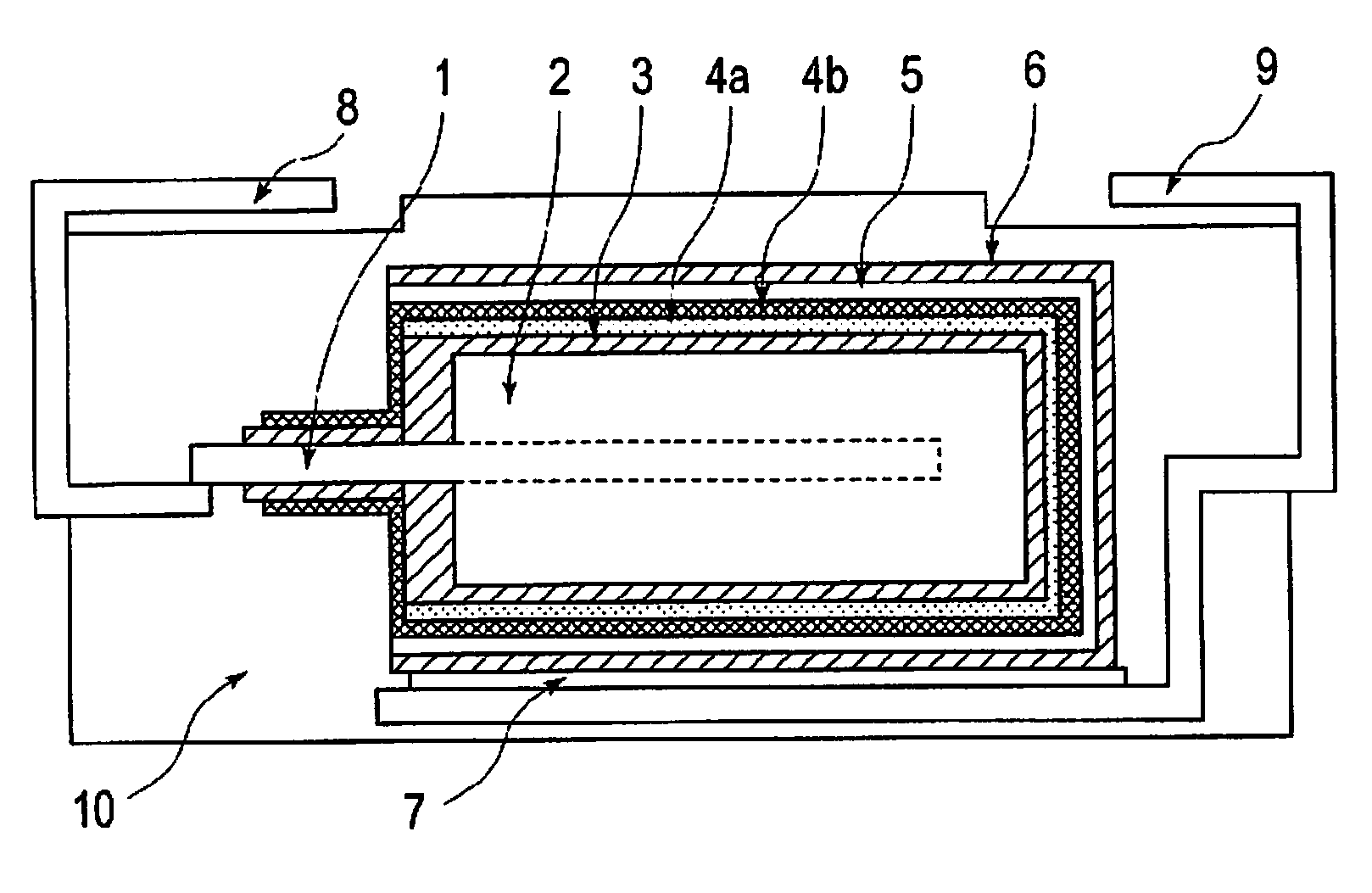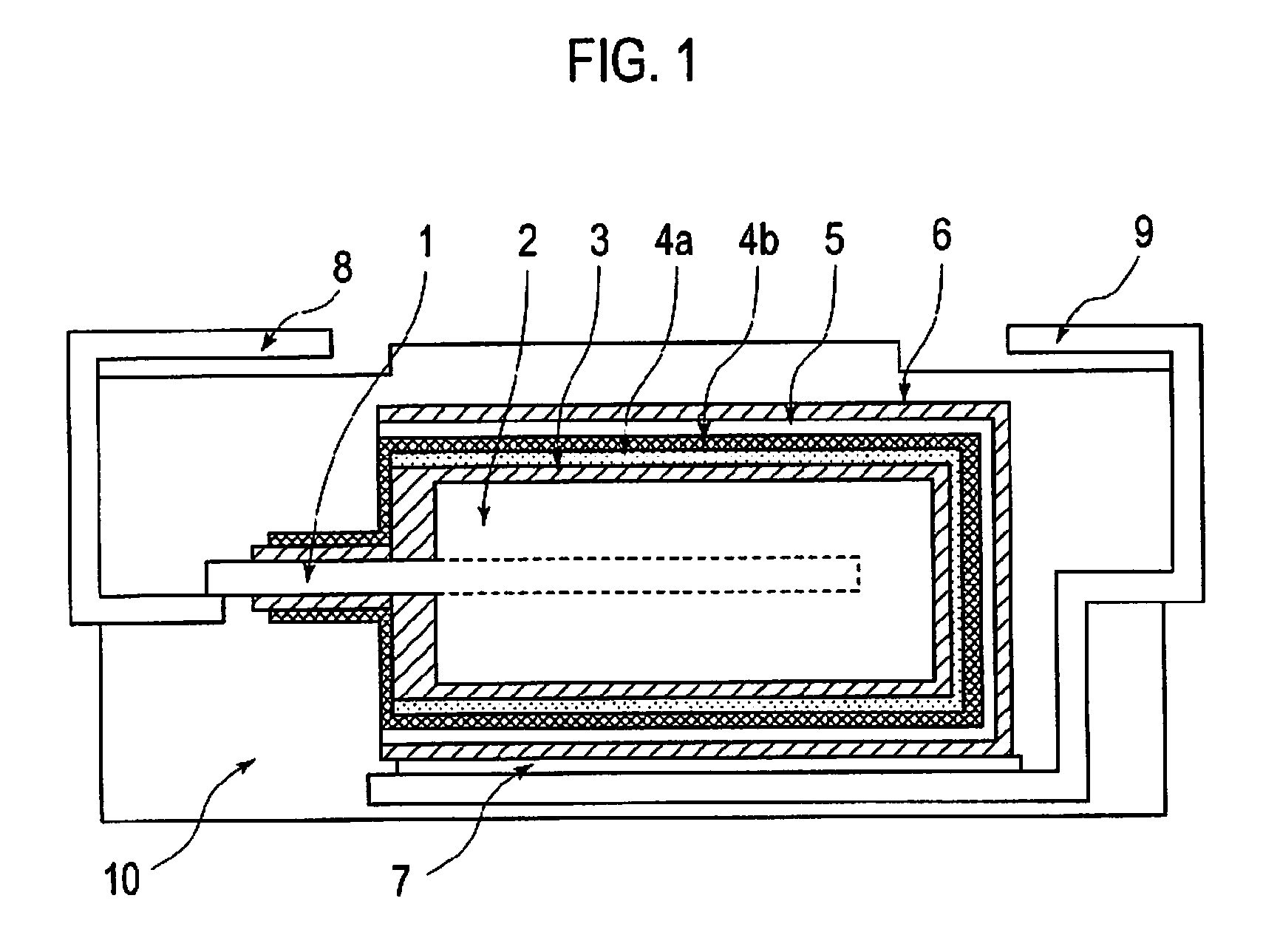Solid electrolytic capacitor
a solid electrolytic capacitor and capacitor technology, applied in the direction of variable capacitors, capacitor dielectric layers, superimposed coating processes, etc., can solve the problems of capacitance decrease, dielectric layer adhesiveness decrease, etc., to achieve the effect of increasing the adhesiveness between the dielectric layer and the first conducting polymer layer, reducing capacitance, and reducing capacitan
- Summary
- Abstract
- Description
- Claims
- Application Information
AI Technical Summary
Benefits of technology
Problems solved by technology
Method used
Image
Examples
experiment 1
Example 1
Step 1:
[0029]By sintering tantalum powder with a mean particle diameter of approximately 2 μm at a temperature of approximately 1400° C., an anode is prepared from a porous sintered compact in which a tantalum metal lead is buried. This anode is dipped in 0.1 weight % of an ammonium fluoride solution, which is kept at 40° C. The anode is anodized at a constant voltage of 10 V for 10 hours, so that a dielectric layer made of tantalum oxide is formed on the surface of the anode.
Step 2:
[0030]Next, the anode prepared at Step 1 is dipped in a 3,4-ethylenedioxythiophene solution containing approximately 0.001 weight % of polyethylene glycol (PEG: mean molecular weight is 1000) in relation to a monomer for 10 minutes. The 3,4-ethylenedioxythiophene solution thus used is a solution containing 2 mol / liter of 3,4-ethylenedioxythiophene. Thereafter, the anode is dipped in a solution containing 0.5 mol / liter of ammonium persulfate as an oxidizer for 10 minutes, and 3,4-ethylenedioxythi...
example 2
[0035]Solid electrolytic capacitor A2 is manufactured in a similar manner to Example 1, excepting that a solution containing approximately 0.001 weight % of polyglycerol (PG: mean molecular weight is 1000) in relation to a monomer is used for forming a first conducting polymer layer in place of the solution containing polyethylene glycol.
[0036]Similar to the foregoing manner, it is confirmed that the first conducting polymer layer contains polyglycerol and a dielectric layer contains fluorine.
example 3
[0037]Solid electrolytic capacitor A3 is manufactured in a similar manner to Example 1, excepting that a solution containing approximately 0.001 weight % of polyvinyl alcohol (PVA: mean molecular weight is 1000) in relation to a monomer is used for forming a first conducting polymer layer in place of the solution containing polyethylene glycol.
[0038]Similar to the foregoing manner, it is confirmed that the first conducting polymer layer contains polyvinyl alcohol and a dielectric layer contains fluorine.
PUM
| Property | Measurement | Unit |
|---|---|---|
| weight % | aaaaa | aaaaa |
| temperature | aaaaa | aaaaa |
| mean particle diameter | aaaaa | aaaaa |
Abstract
Description
Claims
Application Information
 Login to View More
Login to View More - R&D
- Intellectual Property
- Life Sciences
- Materials
- Tech Scout
- Unparalleled Data Quality
- Higher Quality Content
- 60% Fewer Hallucinations
Browse by: Latest US Patents, China's latest patents, Technical Efficacy Thesaurus, Application Domain, Technology Topic, Popular Technical Reports.
© 2025 PatSnap. All rights reserved.Legal|Privacy policy|Modern Slavery Act Transparency Statement|Sitemap|About US| Contact US: help@patsnap.com


